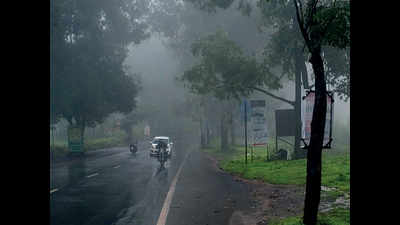Trending
This story is from July 2, 2019
Vidarbha ends with worst June rainfall in five years
Drought-prone Vidarbha, from where the state gets a big chunk of kharif pulses, cotton and fruits, has ended up with the worst June rainfall in five years.

Around 61% of districts in Maharashtra, mainly in the Vidarbha and Marathwada regions, have ended up with a deficient to largely deficient June rainfall.
PUNE: Drought-prone Vidarbha, from where the state gets a big chunk of kharif pulses, cotton and fruits, has ended up with the worst June rainfall in five years.

Though parts of western Maharashtra received heavy rainfall recently, Marathwada in the east and Konkan in the west witnessed the worst monsoon performance this June after 2014. Despite the good rainfall in parts of Maharashtra during the tail end of the month, the entire eastern part of the state has witnessed one of the Maharashtra currently braved one of the worst Junes this year.
Around 61% of districts in Maharashtra, mainly in the Vidarbha and Marathwada regions, have ended up with a deficient to largely deficient June rainfall.This is likely to have an adverse effect on crop production in these districts.
Pulak Guhathakurta, head, climate application and user interface, Office of Climate Research and Services, IMD, Pune, told TOI that a 2012 research by IMD on the increasing and decreasing trends in rainfall over Maharashtra had shown a similar trend.
“In June, only Latur district had shown significant decrease in rainfall. The same trend was evident for July in Wardha, Bhandara, Chandrapur, Osmanabad, Buldhana and Latur. In September, Parbhani , Osmanabad, Yavatmal, Nanded and Gadchiroli had seen significant decrease in rainfall,” he said.
“ There were no significant decreasing trends in any districts rainfall for August and October. One district in June and the six districts in July and September each, which had reported decreasing trends in rainfall, were all from the eastern parts of the state. The study period referred to data from 1901 to 2006,” Guhathakurta added.
The June 2019 rainfall for Maharashtra was 155.3mm, much below its normal quantum for the month at 207.6mm.
MAHA Farmers Producer Company Ltd director Amit Naphade said Vidarbha, which has been most affected by the June rainfall deficiency, is a major producer of cotton, soyabean and pulses like tur or Split Red gram.
“The long delay in monsoon arrival over Vidarbha and the dry spell have already affected the cotton sown in some parts here during the pre-monsoon season. Now, the monsoon will end around September even when June almost had no rains. So the crop will get moisture for fewer days than it does in a normal season,” he said.
A state agriculture department official said, “Eastern Maharashtra usually grows paddy. Prior to transplanting, seedlings need to be raised in a nursery. This process has been delayed by several days in case of paddy due to late arrival of rains and a deficient June. Mung and urad sowing may not happen there because of the late sowing. This is likely to affect their production.”

Though parts of western Maharashtra received heavy rainfall recently, Marathwada in the east and Konkan in the west witnessed the worst monsoon performance this June after 2014. Despite the good rainfall in parts of Maharashtra during the tail end of the month, the entire eastern part of the state has witnessed one of the Maharashtra currently braved one of the worst Junes this year.
Around 61% of districts in Maharashtra, mainly in the Vidarbha and Marathwada regions, have ended up with a deficient to largely deficient June rainfall.This is likely to have an adverse effect on crop production in these districts.
Of the 36 districts in the state, 30, including Mumbai, have recorded negative rainfall departures this June. Though Mumbai still comes under the category of having received 'normal' rainfall, June still has been one of the worst in the last few years.
Pulak Guhathakurta, head, climate application and user interface, Office of Climate Research and Services, IMD, Pune, told TOI that a 2012 research by IMD on the increasing and decreasing trends in rainfall over Maharashtra had shown a similar trend.
“In June, only Latur district had shown significant decrease in rainfall. The same trend was evident for July in Wardha, Bhandara, Chandrapur, Osmanabad, Buldhana and Latur. In September, Parbhani , Osmanabad, Yavatmal, Nanded and Gadchiroli had seen significant decrease in rainfall,” he said.
“ There were no significant decreasing trends in any districts rainfall for August and October. One district in June and the six districts in July and September each, which had reported decreasing trends in rainfall, were all from the eastern parts of the state. The study period referred to data from 1901 to 2006,” Guhathakurta added.
The June 2019 rainfall for Maharashtra was 155.3mm, much below its normal quantum for the month at 207.6mm.
MAHA Farmers Producer Company Ltd director Amit Naphade said Vidarbha, which has been most affected by the June rainfall deficiency, is a major producer of cotton, soyabean and pulses like tur or Split Red gram.
“The long delay in monsoon arrival over Vidarbha and the dry spell have already affected the cotton sown in some parts here during the pre-monsoon season. Now, the monsoon will end around September even when June almost had no rains. So the crop will get moisture for fewer days than it does in a normal season,” he said.
A state agriculture department official said, “Eastern Maharashtra usually grows paddy. Prior to transplanting, seedlings need to be raised in a nursery. This process has been delayed by several days in case of paddy due to late arrival of rains and a deficient June. Mung and urad sowing may not happen there because of the late sowing. This is likely to affect their production.”
End of Article
FOLLOW US ON SOCIAL MEDIA











